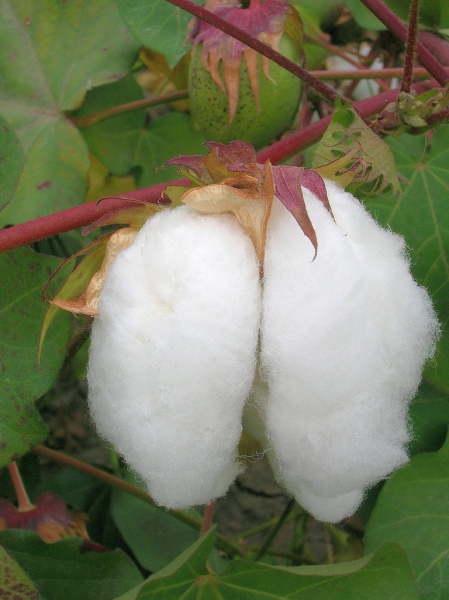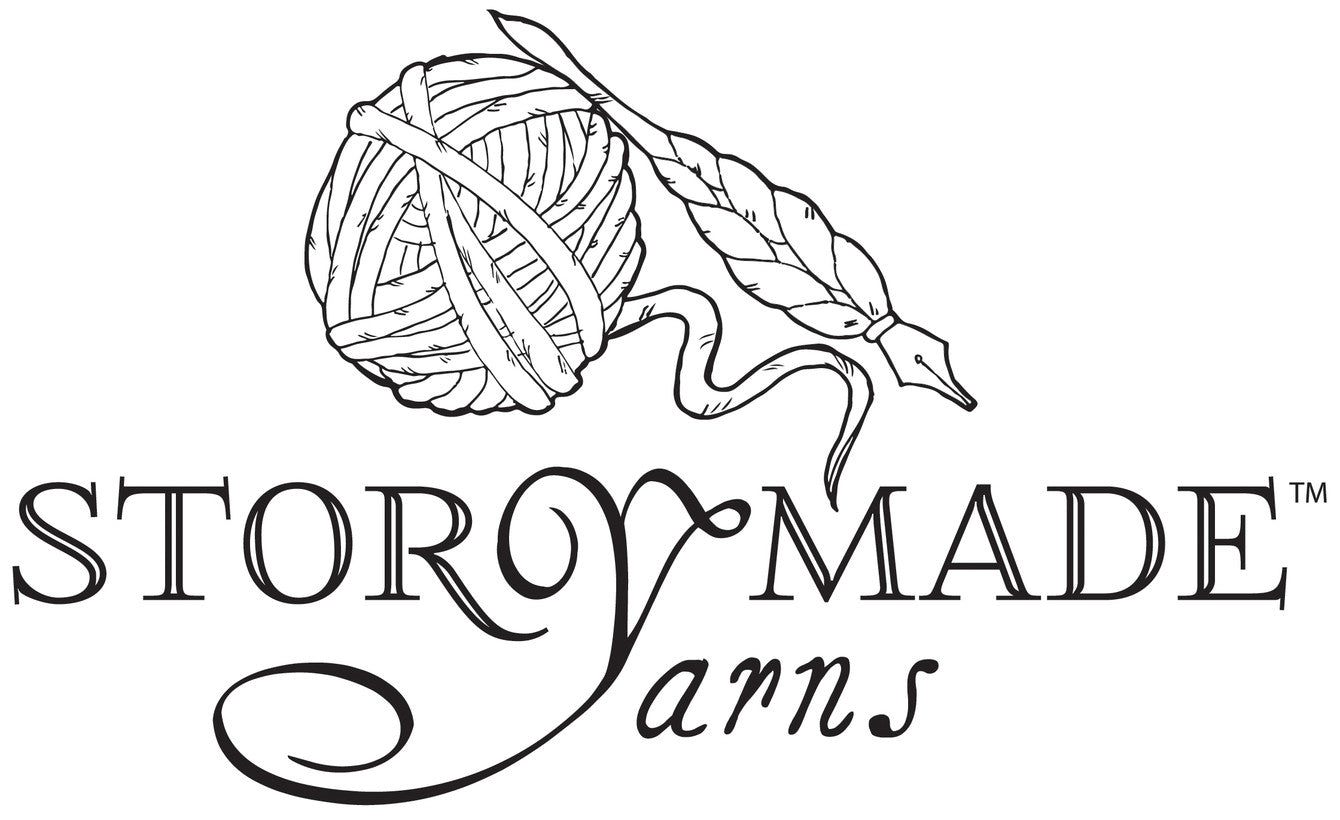In honour of "Spring" (note the sarcastic punctuation - here in Guelph we had snow and freezing rain just yesterday), I thought it would be thematic to talk about warm-weather fibres this month. Little did I know we'd still all be wrapped in our woolens in April. But hey, who are knitters to complain about a little extra sweater weather? The time for plants and their fibres isn't that far away...*jinx*
I decided to focus on cotton because it is the most common plant fibre (THE most common natural fibre in fact), and went on a little fact-finding mission with one goal in mind: to make the label on your cotton goods more transparent.
We all know manufacturers will use any nomenclature they can to make a product seem more desirable. Those little add-on descriptors, such as "superfine," "ultra," "plus," add perceived value to an item, even when the consumer doesn't necessarily know what real difference the terms are defining within the product.
In the case of cotton, a few words I see over and over are "Pima," "ring-spun," and "mercerized." I know from how the fibre is marketed to me that these things are meant to imply a bigger bang for my buck (or, well, in the case of "mercerized" I know it means shiny), but I didn't know the specifics of the terms.
The Cotton Gin
Another thing I wasn't familiar with, and kept bumping into because of my ramblings amongst the fiberistas, was the cotton gin; although now my mom has informed me that everyone of her generation knows what a cotton gin is because it was in their grade school curriculum. They HAD to know things about fibre preparation, and it wasn't even their job. Lucky. Anyway, for those in my boat (the S.S. Biaclou) this is a cotton gin:
This is a hand-cranked version, which isn't too far off from the model that Eli Whitney invented in 1794. Obviously in industrial settings the cotton gin is a big mechanical beast. You can see some of that happening in this video. I liked the one above because you can really see the simplicity of the machine's function: it separates the seeds from the cotton fibre by catching the fibre with the teeth on the roller and pulling it through the holes on the crossbar that are too small for the seeds to pass. The seeds drop down behind the machine and the seedless cotton collects at the front.
(I just need to stop and point out that I got through those two whole paragraphs without a cocktail pun. You're welcome.)
Cotton Species & Varieties
Okay, now that our clueless boat has caught up with the rest of the fleet, let's start back at the beginning.

Gossypium hirsutum
There are more than 30 varieties of cotton plant in the world, but only 4 account for all the commercially produced crops in the world. Gossypium hirsutum (Mexican cotton or Upland cotton), pictured above, accounts for more than 95% of the global market. The other three commercial contenders are: Gossypium arboreum (Tree cotton), Gossypium herbaceum (Levant cotton), and Gossypium barbadense - and here is where the first watchword appears: the barbadense species is known as Extra Long Staple (ELS) cotton, and includes the varieties commonly known as Pima and Egyptian (this is just speculation, but isn't it interesting that the American native "Pima" has replaced the "Egyptian" as the most prized cotton descriptor in the last 10 years...). Let's take a look at that staple:

Gossypium barbadense
That is some pretty dense barba. Of course, the longer the fibre's staple length, the less twist need be applied to the fibre to keep it contained in a yarn. The less twist, the softer the resulting yarn and fabric. Therefore ELS cotton varieties are prized for the softness of fabric they are able to produce.
The Cotton Capital of Canada
Most of the cotton grown in the world comes from the southern United States, Uzbekistan, China and India. About 0% of cotton comes from Canada. But I was curious if anyone was trying it, and I came across this delightful video:
Vivian Reiss on Growing Cotton in Your Front Yard, With 100% of Canada's Cotton Crop from Joel Garten on Vimeo.
I was inspired, and I had my little peat pots on my windowsill already - starting my summer crops of tomatoes, cucumbers and marigolds - so I decided to track down some cotton seed and add them to the mix. I found it where I find most things these days: on Amazon.ca, and when it arrived I dove right in and planted it alongside the veggies.
I posted about it on Instagram, and almost immediately my uncle asked me if I had scarified the seeds. Uh... Nope! Happily, once I started doing the cotton research I discovered that the gossypium herbaceum I had acquired is an easily germinated variety and will probably be okay without scarifying (which is, by the way, sanding or nicking the outside of the seed to make it easier for those first little leaves and roots to make their way out).
Behold! My first little cotton leaf making its way to the sun:
Ring spun or Open-end spun?
Now let's talk processing. Like any fibre, whether you're spinning it on an industrial scale or on your own spindle, it needs to be prepared: carded, combed, and formed into something from which a single strand can be drafted and spun. In the case of cotton on an industrial scale, it is combed into successively smaller rovings before it becomes yarn or thread. For handspinning, if you are spinning cotton on a charka for example (which I had never seen done before January), you form cotton into punis:
You can see one there lying on the table beside the spinner's hand - they sort of look like rolags (another spinning preparation).
Because I wanted to know what manufacturers are bragging about when they say "100% ring spun cotton" I took a look at the different industrial spinning processes for cotton. There are several, but the two main processes are open-end spinning, and ring spinning. Ring spinning was developed first and can be used for many different types of fibre. Open-end spinning was developed in the first half of the 20th century, and is more frequently used with plant and man-made fibres. Open-end spinning is now more widely used than ring-spinning in the cotton industry (hence ring-spinning's claim to specialness). It is much faster than ring-spinning and therefore over the long term more cost-effective. However, open-end spinning cannot command the same range of cotton counts ring-spinning can. It cannot create the same tension in the fibre and so cannot spin it as finely, nor does the fibre get as uniformly smooth and spun in. Therefore open-end-spun cotton is not as strong, soft, or pill-resistant as ring-spun cotton. Read more about this here.
Debunking Ring Spun Misconceptions
When looking for an explanation of the term "ring-spun," and what made it preferable, I found a lot of conflicting information that didn't line up with what I was reading from industrial sources, and what I know from my handspinning experience. Most amusingly, in the FAQ of a t-shirt printing company I found this:
"A slightly different process is used to create Ring-spun cotton. You start with the same cotton fiber strands. But in the Ring-spun process the yarn is made by continuously twisting and thinning the strands making a very fine rope of cotton fibers. The twisting makes the short hairs of cotton stand out, resulting in a stronger yarn with a significantly softer hand.
The number of times you twist the fiber determines how soft it is. In many cases you will see something described as 30 Singles Ring-spun. This a term used to indicate the diameter of a yarn. The smaller the number, the thicker the yarn. The higher the number the thinner the yarn and the softer because it has been twisted more times."
This is the top result on Google when you search for "ring spun cotton"... and it's just incorrect. On top of this, if you go further through these results, you'll find several other t-shirt companies quoting this information in their own FAQs. Apparently they're good at Googling too - and taking the very first result at face value.
I just have to set the record straight here: All yarn ever is created by twisting and thinning fibre strands. If it isn't twisted, it's not yarn - it's roving (or traditional Lopi). The purpose of adding twist is not to make the fibres stick out of the yarn - if this were the case your fabric would pill atrociously; and in fact one of the disadvantages of open-end spinning is that the fibres on the exterior of the yarn are looser (i.e. stick out more) which makes the thread/yarn weaker and pill more. Furthermore, the thinner yarn is not thinner because it has been twisted more (for heaven's sake!) but because it has been drafted thinner and there are fewer cotton fibres in the thread. The more twist you add to a yarn the less soft it becomes. However, it is true that ring-spun cotton can be more finely and smoothly spun with better fibre integration, giving its resulting fabric a softer, denser hand, less likely to pill.
Okay, I'm going to step down off my soapbox, and move on to mercerization.
Mercerized Cotton - an inside look
Most fibre artists know the difference between plain and mercerized cotton. Mercerized cotton has a plump sheen, and distinctly lacks the fuzziness of most plain cotton yarns. In fact the process has become so common that some yarn companies no longer bother to indicate mercerization on their labels (... or maybe we're supposed to believe that their variety of Pima cotton is just naturally that shiny and smooth...). However, I for one am fascinated by the trials cotton yarn has to go through to come out beautiful and smooth. (Mercerized cotton is like the beauty pageant contestant of cotton yarn - its turn-out is perfect, but behind the scenes there's caustic soda, botox, a pseudo-medieval stretching rack, and vaseline in strange places.)
Mercerization was developed by John Mercer, a British textile scientist, in 1844. Today the process involves putting the yarn or thread under tension and immersing it in caustic soda, which causes the cotton to change at a cellular level. I found this image in a slideshow about the process.
Here you can see magnified the effects of mercerization on the cotton cell structure. The cells are plumped up (cotton botox!) which creates a higher surface area for reflecting light = extra shiny; and a denser, smoother fibre = extra smooth.
How to use your new tools
Now that we've got a good foundation in cotton-speak, what are some ways this will come to play in our lives (just because I'm a firm believer that education should have a real world application... I developed this belief AFTER I received my shiny film studies degree)? Here are some ideas.
- You will now be able to justify at length to your partner why you bought the more expensive hand towels ("but honey, they're RING SPUN, let me take you through the process...").
- You will be able to pick the right fibre for the job: department store cotton yarn for the dishcloth, pima mercerized cotton yarn for the lacy tank top.
- Your bed-sheet experience will never be the same.
If you have a moment, let me know how else you're going to apply the knowledge...

